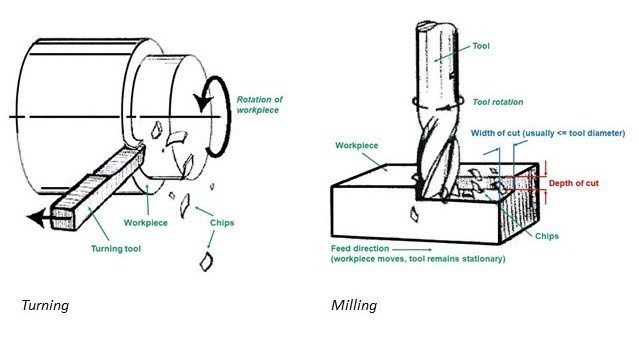
Computer Numerical Control (CNC) technology is at the forefront of the precision machining industry, yielding greater control, more accurate results, and a reduced need for manual intervention during the manufacturing process.
Both CNC turning and CNC milling harness cutting-edge automation technology. However, despite sharing some similarities, the two processes offer different benefits and are suited to different applications.
What are the similarities and differences between CNC turning and CNC milling, and which should you choose for your engineering project?
CNC Turning And Milling: A Short Summary
- CNC turning: In this process, the workpiece is rotated against a cutting tool to remove the material in the desired way. Usually, a round bar stock is used with this method to produce cylindrical components.
- CNC milling: The workpiece is held in a stationary position, with the cutting tool spinning against it to remove unwanted material. Primarily, milling uses square or rectangular bar stock.
The Similarities Between CNC Turning And CNC Milling
Aside from the reliance on CNC technology to achieve optimum accuracy and speed, CNC turning and milling share some common traits:
1) Subtractive engineering: Both CNC turning and milling removes material from a workpiece in a carefully controlled way. Chips of waste material are generated as the workpiece is machined to the required profile or length.
2) Suitability for materials: CNC milling and turning are suitable for a variety of metals, including aluminium, brass, copper, steel, and titanium. Thermoplastics can also be machined using these methods. Materials that are too soft and pliable, such as rubber, or too hard and brittle, such as ceramic, can be extremely difficult to machine.
3) Heat generation: Turning and milling both generate heat, so cooling fluid is usually required to mitigate this and prevent warping.
Should I Choose CNC Turning Or CNC Milling For My Project?
Both CNC turning and milling offer valuable speed and cost advantages for engineering projects, including:
- Highly precise machining: Producing parts to exacting specifications, turning, and milling can achieve incredibly tight tolerances, to better than tenths of microns.
- Rapid machining: Cutting operations are performed quickly, with no time lost to changing cutting tools. CNC mills, for example, feature rotating carousels that can hold many tools which are automatically interchanged during operations.
- Less errors: Because CNC machining is guided by a computer, cutting is highly precise, with no possibility of errors being made. Incredibly complex parts can be machined in a short time without the risk of human error.
- Cost-efficiency: Due to the speed of CNC milling and CNC turning, these processes are very cost-efficient and far more affordable than comparable processes, such as 3D printing.

While there are some disadvantages of CNC turning and milling – the amount of material wastage, for example – it’s more important to consider the application when deciding which method is most suitable for your engineering project.
The decision to use turning or milling depends on the design of the part and the required features. Milling is most suited to square, rectangular, or flat parts, whereas turning is a better choice for cylindrical components.
Contact Hone All For More Information
For professional, expert advice about CNC milling or turning, please get in touch with Hone-All on 01525 370666 or send us a message to arrange a free, no-obligation quotation.






